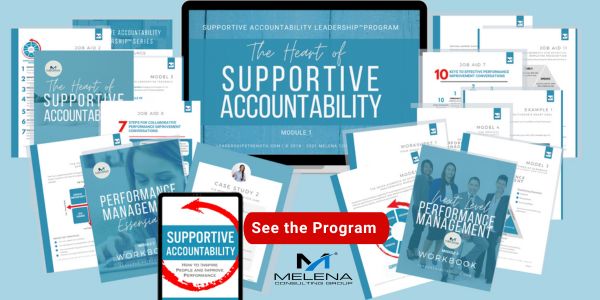Performance improvement conversations are often the most difficult to have with employees.
Letting employees know they’re not performing at expected levels can be awkward and stressful.
But it doesn’t have to be that way. You can have performance conversations without the angst.
Apply the 10 keys below.
10 Keys to Effective Performance Improvement Conversations
Key 1 – Immediacy
Hold performance improvement conversations immediately following the discovery of difficulties. If the concerns involve an incident, the events will still be fresh in people’s minds. Immediate feedback allows the employee to correct issues quickly and prevent escalation.
When you delay feedback, you’re nonverbally approving of unacceptable performance and behavior. Your silence and inaction are detrimental to your organization’s work culture. You have a responsibility to promote accountability.
Key 2 – Timing
Some circumstances may require that you wait for better timing before having performance improvement conversations. These circumstances can range from the purely logistical to those involving various levels of sensitivity. Here are just a few examples:
- The employee suffered an unfortunate event just before your scheduled meeting. This could include a death in the family, an injury, the diagnosis of a serious illness, or another unexpected incident taking an emotional toll on the employee.
- You work in a unionized environment, and the issue you’re addressing is the subject of labor negotiations.
- The issue you’re addressing is tied to an investigation, and you must wait for the results before proceeding.
- The employee filed a grievance or complaint shortly before the performance issue came to light. The timing can give the employee the erroneous impression that the performance improvement conversation is in retaliation.
It’s important to be aware of sensitivities that could affect timing, but these don’t relieve you of the responsibility of addressing performance issues. Work closely with your manager and human resources to ensure your timing is appropriate.
Key 3 – Honesty
To gain and maintain your employee’s trust, be as honest and transparent as appropriate. Don’t sugarcoat or minimize the issue.
It’s disconcerting to employees when supervisors have lighthearted conversations with them, then issue a written warning or add unfavorable language to their performance evaluations. If an issue is serious, be candid about it.
Employees may not always like or agree with your feedback, but they will appreciate that you speak the truth. They don’t have to guess how they’re performing because you consistently let them know with honesty and transparency.
Key 4 – No Assumptions
Don’t make assumptions about the causes of poor performance or speculate about the employee’s intentions.
Assumptions have a dangerous way of tainting your perspective and undermining objectivity. Sure, you may have some preliminary thoughts on the situation based on the information you have already gathered.
However, give the employee an opportunity to share his side of the story to get the complete picture. Gather all the pertinent facts before arriving at conclusions.
Key 5 – Focus
When possible, focus performance improvement feedback on one overarching issue or area of concern. If you address concerns as soon as they arise, they won’t accumulate.
Overwhelming the employee with too many problems at once will make it difficult for him to focus on the most pressing issue at hand.
If you have multiple unrelated concerns, consider prioritizing them in order of impact, severity, and urgency and concentrating on the most pressing issue first. Then systematically focus on the others. However, there may be exceptions, and you will need to exercise sound judgment. Your manager and human resources can help you determine the best approach.
Key 6 – Expectations
Base performance improvement conversations on expectations you have already communicated. You can’t hold the employee accountable for meeting expectations you haven’t expressed.
Provide concrete examples of how the employee isn’t meeting established standards and what she needs to accomplish to be successful. Use the information from your performance monitoring activities as a springboard for conversation.
Key 7 – Support
Assess the employee’s support needs. Ask him what he needs from you to be successful. Does he need tools, training, or equipment? Or does he simply need more autonomy? Sometimes employees actually need a little less of you.
If the employee doesn’t have the necessary support to meet expectations, it will hinder performance.
Honor the employee’s support requests as much as reasonably possible. If any of the requests are unfeasible, explain why so he knows you considered them. Neglecting to honor support requests without explanation will negatively affect the employee’s trust in you.
Your responsibility is to set the employee up for success by providing the necessary support. His responsibility is to use the support to achieve success.
Key 8 – Agility
There’s no script for effective performance improvement feedback. If you try to use one, you may end up frustrated when the employee deviates from it.
Tailor your approach to each unique situation and individual. Plan for the performance improvement conversation, but be agile and keep in mind that the employee’s responses or reactions may require you to shift gears quickly.
Don’t go into the discussion expecting for it to go 100% as planned. It seldom does.
Key 9 – Preparation
Preparing for the conversation will relieve some of the stress — yours and the employee’s.
If the conversation is serious or you must issue something in writing, try to schedule the meeting towards the end of the employee’s work shift. Should the employee experience a negative reaction to the conversation, you can offer the option of going home early.
If the employee doesn’t feel well after the interaction, he may not be able to focus on his work and his judgment, productivity, customer service, and other performance areas may be adversely affected.
If you’re unable to schedule a meeting later in the employee’s shift, offer the employee a few minutes to go outside and get a breath of fresh air before returning to work. However, the employee may still need to go home early, depending on how he feels.
Have facial tissue on hand in case the employee cries or sweats during the conversation. Your approach should be one of supportive accountability; however, it’s hard to predict how performance improvement conversations will turn out. Even if you think the chat will be casual, the employee’s reaction may be different than anticipated.
Key 10 – Seeking Guidance
Before you have performance improvement conversations, share your planned approach with your manager and human resources. Write down a brief outline of the topics and facts you plan to cover and what you intend to say.
If your organization has an employee union, ask your manager or human resources whether a union representative must be present during the conversation.
Also, ask about your organization’s procedures for union involvement. Should your manager or human resources participate in the conference if a union representative is present? How much notice do you need to give the employee about the meeting? Are there any other steps you need to take?
Leading effective performance improvement conversations takes intentionality, preparation, and practice. These ten keys will help you set the stage for conversations that yield positive results.







